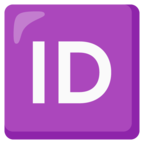🆔 ID Button Emoji
🆔 ID Button Meaning
The characters "i" and "d" are arranged in a square to form the emoji known as the id button. In case you weren't aware, the term "identification" is referred to by the acronym "id". Use it when you need someone's id or to remind them to bring it if you are heading somewhere where you need to be at least a certain age to enter. If someone intends to pay for the day with credit rather than debit, use it along with the credit card emoji to inform them that they will need to present their id. Or you can ask for an id by sending it along with the man or woman image.
The ID button emoji was introduced in 2010 and released as part of the Unicode 11.0 standard. This emoji can be found under the symbols category. Because the ID button emoji has been around for quite some time, it should display correctly in the majority of operating systems.
🆔 Emoji on Different Devices
Here you'll find a range of emojis on how they will look using different operating systems.
Each company will design an emoji according to their own style. Here we have listed the most popular platforms around to see how the emoji will look on their screens.
Depending on the operating system version, the images may still look different to your display.
- Google

- Apple

- Facebook

- Twitter

- Windows

- Samsung

🆔 Worldwide Trend
🆔 Developer Codes
- Short Codes:
- :id:
- Hex Code:
-
🆔 - Decimal Code:
-
🆔 - Punycode:
-
xn--147h - URL Escape Code:
-
%F0%9F%86%94 - JavaScript & JSON:
-
\ud83c\udd94 - CSS Code:
-
content: '\1F194';
